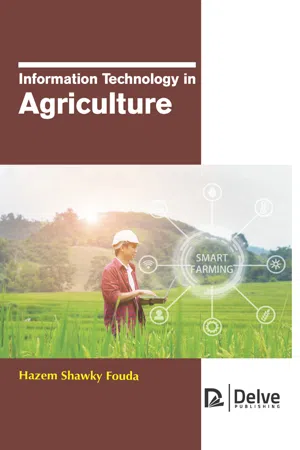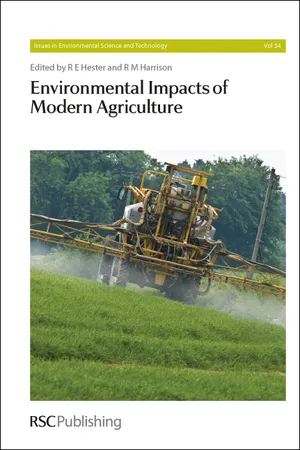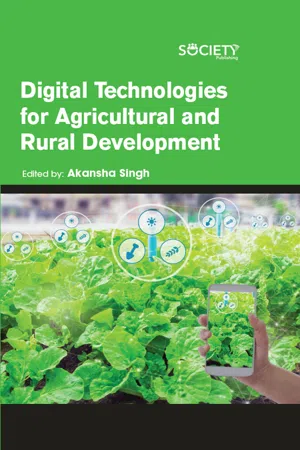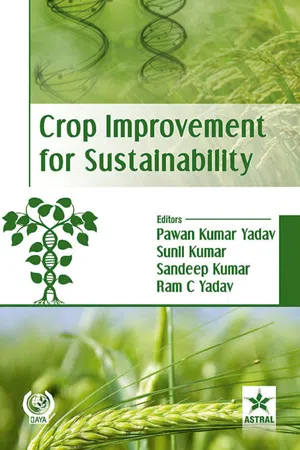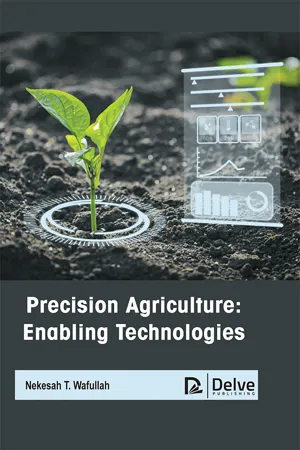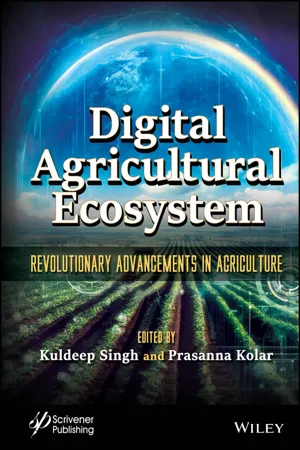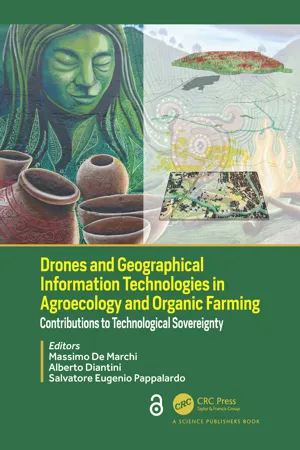Geography
Impact of Technology on Agriculture
The impact of technology on agriculture refers to the influence of technological advancements on farming practices and productivity. This includes the use of machinery, precision farming techniques, and biotechnology to improve efficiency, yield, and sustainability in agricultural production. Technology has the potential to revolutionize the agricultural sector by addressing challenges such as food security, resource management, and environmental impact.
Written by Perlego with AI-assistance
Related key terms
1 of 5
10 Key excerpts on "Impact of Technology on Agriculture"
- eBook - PDF
- Hazem Shawky Fouda(Author)
- 2019(Publication Date)
- Delve Publishing(Publisher)
The expansion of agricultural sector is now depending upon the IT for providing the essential and location specific technologies for the farmers. This will help to provide a timely and skilled advice to the farmer. IT helps in developing agricultural extension along with the expansion of agricultural research and education system. Through the smart exposures of agricultural teachers and educational planners, class rooms, agricultural learners and virtual class, the development of the agricultural education management is taking place. The information technology has a key role for future in resource documentation for agricultural extension management, as the methods of extension and the connection between the research and extension. Information technology needs to be supported in agricultural research management in order to decide the prioritization of research areas and the words-based and non-textual documentations. In agricultural sector, the impact of information technology can be in the areas such as input management, watershed management, crop forecasting, command area management, drinking water potential mapping precision management, land and water resources development, fishery management, natural disaster management, post-harvest management and hill area development. Impact of Information Technology on Agricultural Sector 201 Figure 9.4: Agriculture in hilly areas. Source: https://pixabay.com/photos/agriculture-landscape-hill-nature-3252832/ The role of IT is now becoming noticeable in the agriculture sector. The topics related with crop production and crop protection, IT can be used to convey and expand the information to the people. In order to avail the benefit of information technology , people need to have a computer or any computing device such as smartphone. Only the circulation of information cannot support the growth in agriculture. - Karen, S T(Authors)
- 2018(Publication Date)
- Agri Horti Press(Publisher)
1 Agriculture Environment, Rural Sociology and Food System 1 Agriculture Environment, Rural Sociology and Food System Environmental impact of agriculture The environmental impact of agriculture varies based on the wide variety of agricultural practices employed around the world. Climate change and agriculture are interrelated processes, both of which take place on a global scale. Global warming is projected to have significant impacts on conditions affecting agriculture, including temperature, precipitation and glacial run-off. These conditions determine the carrying capacity of the biosphere to produce enough food for the human population and domesticated animals. Rising carbon dioxide levels would also have effects, both detrimental and beneficial, on crop yields. The overall effect of climate change on agriculture will depend on the balance of these effects. Assessment of the effects of global climate changes on agriculture might help to properly anticipate and adapt farming to maximize agricultural production. At the same time, agriculture has been shown to produce significant effects on climate change, primarily through the production and release of greenhouse gases such as carbon dioxide, methane, and nitrous oxide, but also by altering the Earth's land cover, which can change its ability to absorb or reflect heat and light, thus contributing to radiative forcing. Land use change such as deforestation and desertification, together with use of fossil fuels, are the major anthropogenic sources of carbon dioxide; agriculture itself is the major contributor to increasing methane and nitrous oxide concentrations in earth's atmosphere. Conceptualization of technological change in agriculture Technological change is among a small handful of topics in what is now referred to as the sociology of agriculture — along with part-time farming and analysis of the farm family — that have received attention during all three major phases in rural sociology.- eBook - PDF
- R M Harrison, R E Hester(Authors)
- 2012(Publication Date)
- Royal Society of Chemistry(Publisher)
Agricultural land for bio-energy production will be an important factor in determining this decline and its influence on prices of other crops. The scenarios also point, in general, towards an increase in productivity and efficiency of farming methods. The influence of world market prices for agricultural commodities and the direction of CAP reform are common themes affecting land use futures. In general socio-economic, technological and political factors are considered likely to be the most important drivers for land use change in the next 30–40 years. 82 10.2 Technology Change and Land Use Regarding the role of agricultural science and technology as it affects land use, Figure 11 develops the systems framework shown earlier in Figure 1 to demonstrate how seven key aspects of technological change can help improve agriculture productivity and environmental performance with implications for future land use. 33 The first three aspects (Figure 11, Table 5) mainly concern improvement in inputs to farming systems, namely genetic material, reducing abiotic and biotic Waste Product Farm production system Reduce stress Air, water and soil quality; biodiversity Agricultural technology Output of goods and services Including positive and negative environ-mental impacts Land Labour Genetic improvement Information Energy Finance Figure 11 Schematic diagram showing seven key areas (indicated by the vertical dotted lines) where technology can affect the performance of agricultural systems and thereby land use. 24 Joe Morris and Paul J. Burgess Table 5 Seven areas within agricultural systems which can be affected by technological change, example technologies, typical aims in using the technology and possible effects on land use. 33 Area Example technologies Typical aim in using the technology Effect on land use 1. Genetic improvement Plant and animal breeding, and genetic modification. To increase yield and/or quality per area of crop or per animal, or per unit time. - Akansha Singh(Author)
- 2019(Publication Date)
- Society Publishing(Publisher)
The activities required to create in- Digital Technologies for Agricultural and Rural Development 188 house volume to observe the processes and outputs of farming technology creation. This states a promise to creating an institutional statement and to coordinating central syntheses and guidance with country-level experience. Schemes in the relation to farming technology creation should put strong stress on local organization building and should see that farming is addressed in an intelligible fashion in lack planning. A sympathetic of the more than one impacts and second-order belongings of technology should notify the policy procedure. Lastly, giver agencies required to hike their collaboration and coordination in of technology generation (Figure 7.5). Figure 7.5: Water sprayer reduces human efforts. Source: http://www.mountpleasantgranary.net/blog/images/Big-Tractor.jpg 7.3.1. Increasing Agricultural Productivity is Central to Reduc-ing Poverty – Technology’s Role Farming plays a vital role in plummeting poverty. Half this project the great numbers of poverty facing citizen engaged in it. Around 75% of those living on less than US$1 a day – the globally approved definition of absolute poverty is that those who live in rural areas (IFAD, 2001) and agriculture is an important living source. It is projected that 70% of sub-Saharan Africa’s labor force and 67% Future of Technology in Agricultural and Rural Development 189 of South Asia’s, job is in farming (Maxwell, 2001). But the argument in favor of farming as the poverty-easing sector par fineness rests on more than populace figures. Developments in farming output have an influential knock-on result to the remaining of the economy by: making employment in neighboring sectors such as food dispensation and input supply as well as straight in agricultural; cumulative the supply of reasonable food; and inspiring and supporting wider economic growth and development.- eBook - ePub
Agribusiness
An International Perspective
- Julian Roche(Author)
- 2019(Publication Date)
- Routledge(Publisher)
CHAPTER4
The role of technology
Introduction: a difference in approach
I imagine that most readers of this book are interested in the business of agriculture, in one or more capacities of regulator, lender, investor, supplier or adviser. It is always necessary to decide, even for scientists and certainly for business people, what research is needed, and for what purpose, and then to select only the latest and/or most relevant research. Agricultural scientists are often, it must be recognised, not especially well versed or even interested in economics or finance. Even basic concepts such as cost-benefit analysis are often alien, whilst on the other hand scientific jargon is rife. The best way to approach the dichotomy between their vast experience, dedication, research and achievements, and their oft-evidenced disinterest in finance, is to regard agricultural research as a data resource for financial decision-making. Certainly, the application of agricultural science has major financial impacts. This chapter has been written as an introduction to agtech and agricultural science with that aim in mind.Principles of agricultural science and technology
What is agricultural science? Agricultural research – the Australian government tells us – is not an actual scientific discipline in its own right. Rather, it is a broad term to describe the application to agriculture of many different scientific disciplines and endeavours, combined with the objective of achieving improvements in agricultural output, sustainability and, sometimes, profitability. Primarily, but perhaps regrettably, agricultural science integrates scientific disciplines in which research may have been carried out without an explicit end-point application. Traditionally this has involved all of botany, zoology and soil science including, inter alia - eBook - PDF
- Yadav, Pawan Kumar(Authors)
- 2018(Publication Date)
- Daya Publishing House(Publisher)
enterprises. Keywords: Agriculture, farming, information technology, rural, population and internet. Introduction The potentiality of agriculture in economic growth of a nation was recognized long back in 2009 by Byerlee and Sadoulet. Despite tremendous eforts, the agricultural production and productivity in the developing countries has declined in the last few decades. One of the potential clarifcations for this reduced yield is the ignorance of farmers about advanced agricultural techniques in the developing countries since 1970. The impetus of digital technology in the modernization of agricultural practices has been determined by various studies (Feder, Just and Zilberman, 1985; Foster and Rosenzweig, 1995; Foster and Rosenzweig, 2010). Whereas the particular bases of technology acceptance depend on the seting and type of technology, usual features recognized in academic and observed fctions comprise of education, wealth, tastes, risk preferences, complementary inputs and access to information learning. Among all these, the role of asymmetric and expensive information has received the highest atention. Agriculture extension services have been started by government and international institutions to overcome the information failures regarding technology implementation (Anderson and Feder, 2007). In 2005, there were 5, 00,000 agriculture extension personals out of which 95% were working in public agriculture extension services. Insipte of huge amount of investment in extension programmes which has gone through a lot of criticism and its existence is facing huge problems still the evidences of their infuence on agricultural technology and knowledge adoption remains limited (Anderson and Feder, 2007). A unique opportunity to spread information by public and private collaboration is provided by rapid development of ICTs in developing nations. Increased efciency, reduced costs and enhanced productivity determines the role of ICTs in agriculture. - Arne Hallam(Author)
- 2019(Publication Date)
- CRC Press(Publisher)
12 Technology and Its Impact on American Agriculture Marvin T. Batte and Roger Johnson Technological change is generally viewed as a major determinant of structural change. The mechanization of farming as an outgrowth of the industrial revolution has been largely responsible for the dramatic increase in farm size over the last 70 years. A study by the Office of Technology Assessment concludes that technology and associated economies of size, specialization, and capital requirements have had an important influence on structural change in agriculture (U.S. Congress, OTA 1986, 117). This chapter begins with a brief historical review of technological change and its impact on farm structure. The classical diffusion model and the induced innovation hypothesis are explored. Models of firm-level and aggregate (sector-l~?vel) impacts of technology adoption are presented. Following this is a description of emerging agricultural technologies, a discussion of differences in these from previous technologies, and suggested impacts of the emerging technologies on future farm structure. Impacts of Technological Change on Structure Tweeten (1986, 1) has characterized technological change in agriculture into three distinct revolutions. The first featured the wheel and simple hand tools, irrigation and domestication of plants and animals. This revolution '1asted for thousands of years and was still underway when the first white settlers came to America. The second revolution began with the industrial revolution in Britain during the late 309 18th century. It featured cheap steel and steel farm implements, railroads, and steam power. The third revolution began about 1920. Primarily mechanical, chemical, and biological in nature, it featured rural electrification, chemical fertilizers and pesticides, improved plant and animal genetic material, and the modern tractor and its complement of machinery.- eBook - PDF
- Nekesah T. Wafullah(Author)
- 2023(Publication Date)
- Delve Publishing(Publisher)
Technologies in Precision Agriculture 67 as accelerometer, gyroscope, and GPS. A warning flashes on the phone screen when the stability index falls below a specific threshold. When the index reaches zero, signifying a rollover or accident, the application sends an email to emergency contacts with the date, time, and GPS coordinates of the accident area. Agricultural Land Management: Aggregated geo-data from agricultural areas can be used for monitoring and to help policymakers make decisions. Map-IT, a crowdsourcing tool for collecting geographic information about small things and agricultural areas, can help with this. A user collects geo-data by taking a snapshot of the area/item of interest and drawing an outline of the thing on a smartphone screen. The user can label the object using speech recognition or typing, and then upload it to a server for further analysis. To determine the object’s original size and shape, their implementation used the Douglas-Peucker algorithm to first simplify the user’s outline. The coordinates in the photo are then projected to real- world coordinates using data from built-in inertial sensors, the distance of the object from the camera, and GPS position, creating a geo-object with precise original geometry. Information System Applications In many industrial sectors, including agriculture, information is critical to making efficient decisions. Information is widely acknowledged as a tool that can assist farmers in increasing agricultural productivity. Farmers can choose the sort and number of crops to plant, as well as where to sell their products, based on current information on prices and market demands. Farmers can take measures to limit damage by receiving timely crop disease warnings and projections. Farmers benefit from updated farming knowledge since it informs them of new strategies to increase crop yields. - eBook - PDF
Digital Agricultural Ecosystem
Revolutionary Advancements in Agriculture
- Kuldeep Singh, Prasanna Kolar(Authors)
- 2024(Publication Date)
- Wiley(Publisher)
Instead of concentrating exclusively on production volume, DEA enables us to assess the effectiveness and productivity of states in producing outputs given the resources at their disposal. In agriculture, efficient resource use is crucial to productivity and sustainability. 7.2.6 Implementation of ICT (Information and Communication Technology) in Rural Tribal Farming Communities This case study focuses on providing agricultural extension services to rural tribal farm- ing communities through ICT, which helps save farmers time and money. Digital technol- ogies, such as indoor home vertical farming, livestock technology, advanced greenhouse methods, precision agriculture, and blockchain, have revolutionized the agricultural sector [2]. Adopting ICT for political, economic, and social development, focusing on aiding the underprivileged and organizations, has become increasingly dependent on technology over the past 50 years to facilitate communication and information processing across all facets of their business. Academics in the marketing field have likewise struggled to create the proper explanatory and prescriptive frameworks to permit a thorough analysis of this evo- lution [30]. This is supported by the contribution of ICT to decision quality, information exchange, and interorganizational connections [31]. There are many indications that the use of ICT has significantly influenced how marketing practices have evolved, and many people believe that technical difficulties will continue to play a major role in how marketing develops in the future [30, 32]. The country’s economic and social development depends heavily on agro-informatics. Traditionally, the two most important agricultural improvement variables were infrastruc- ture and human resources. ICT, consisting of the three major technologies listed below, can play a significant role in keeping feasible information. According to the task group on - eBook - ePub
Drones and Geographical Information Technologies in Agroecology and Organic Farming
Contributions to Technological Sovereignty
- Massimo De Marchi, Alberto Diantini, Salvatore Eugenio Pappalardo, Massimo De Marchi, Alberto Diantini, Salvatore Eugenio Pappalardo(Authors)
- 2022(Publication Date)
- CRC Press(Publisher)
Can we use the map to change the world? And how the act of mapping can promote awareness and empowerment? This chapter explores the reflections within geography and cartography sciences with a consolidated epistemological and empirical habit about the key role of maps in changing the world, starting from the pre-digital era. With the consolidation of Geographic Information Systems and the emergence of GIScience in the 1990, participatory GIS and critical GIS reinterpreted the ‘mapping for change’ in the light of inclusive liberation technologies in the empowerment of the weak and marginalized authors in cities and rural contexts. The chapter offers a theoretical compass to orient among the different practices: from ‘material’ cartography to ‘immaterial’ participatory GIS, Volunteered Geography, critical geodesign and neogeography. Geographical technologies are a sort of two-faced Janus as they not only unfold a world of possibilities and freedom, but also are part of a world of injustice. Despite the low interactions, mostly informal, in the last decades among the science of geographical information and agroecology, there are many areas of common interests and mutual interaction and co-operation for technological sovereignty.2.2 Agroecosystem: Place, Territory, Scale
Place matters (De Blji, 2009 ); the placed-based approach of agroecology is identifiable in the concept of agroecosystems with the key formalization of Conway (1987 ). Agroecosystems are ecological systems modified by societies to produce food, fibers and other agricultural products. The structural and dynamic complexity of agroecosystems arises mainly from the complexity of the interactions among socio-economic and ecological processes. Agroecosystems are the form of territories in many contexts where societies co-evolve with ecosystems, basing social reproduction on farming, forestry, and animal husbandry or fishing. Territories (agroecosystems) are bi-modular systems (society-ecosystem) in co-evolution (Nir, 1990 ; Vallega, 1995 ). Every system represents the environment of the other and the relations between the two systems are not pure instructions, but interactions (Maturana and Varela, 1987 ): each of the two systems falls within the fields of possibilities of the other. Systems lie in the quantitative dimension of the parts (and the relationships between them), in the quality of the same, but also in the eye and mind of the observer. Therefore, complexity is not necessarily a property of reality, but can be a characteristic of description: different generations of system thinking generated different views on the agroecosystems (Vallega, 1995 ; Checkland, 1984 ). The agroecosystem can be analyzed by focusing on four components: space, time, flows, and decisions (Conway, 1987 ). The unicity of place and the specificity of time make the difference in observations and actions, either in the seasonal changes or in the short or long time changes. Place and time influence and are influenced by relations (flows of materials, energy, and the immateriality of decisions), creating the complexity of agroecosystem boundaries, more influenced by socio-economic relations than by the physical limits of ecosystems (Conway, 1987 ). If the physical limits of a rice pond can be easily determined in terms of spatial occupation or water flows, the social and economic relations are more undefined: Where is rice sold? Where are inputs acquired? How is extra agriculture working time invested? Agroecosystems are complex territorial systems, livelihood systems, combining farming and other types of activities, with flexible boundaries and many scales combined by a multiplicity of interacting levels. The co-evolution of agroecosystems is based on some properties (Conway, 1987 ; Lopez-Ridaura et al., 2002), like productivity, stability, sustainability, equity, and self-reliance. Productivity in agroecology goes beyond the yield – it is the output related to the applied inputs (working time, energy, products). Outputs can be work opportunities, cash, food security, aesthetic values, and a complex combination of personal, collective, social, psychological, economic, and spiritual well-being. For Conway (1987
Index pages curate the most relevant extracts from our library of academic textbooks. They’ve been created using an in-house natural language model (NLM), each adding context and meaning to key research topics.
